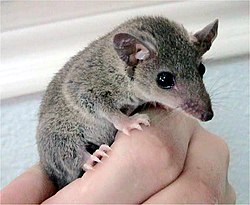| Short-tailed opossums | |
|---|---|
 | |
| Gray short-tailed opossum (Monodelphis domestica) | |
| Scientific classification | |
| Kingdom: | Animalia |
| Phylum: | Chordata |
| Class: | Mammalia |
| Infraclass: | Marsupialia |
| Order: | Didelphimorphia |
| Family: | Didelphidae |
| Tribe: | Marmosini |
| Genus: | Monodelphis Burnett, 1830 |
| Type species | |
| Monodelphis brachyura | |
| Species | |
| Synonyms | |
| |
Monodelphis is a genus of marsupials in the family Didelphidae, commonly referred to as short-tailed opossums. They are found throughout South America. The genus includes a model organism (M. domestica) and one of the few semelparous mammals (M. dimidiata). As of January 2019 [update] , the most recently described species is M. vossi. [1]